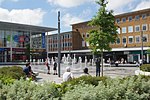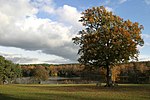Thomas Bennett Community College
1959 establishments in EnglandAcademies in West SussexBuildings and structures in CrawleyEducational institutions established in 1959Secondary Schools in Crawley ... and 2 more
Secondary schools in West SussexUse British English from February 2023
Thomas Bennett Community College (TBCC) is a secondary school with academy status for pupils aged 11 to 19. It caters to approximately 1200 pupils in Years 7 to 14, including 160 in its sixth form. Thomas Bennett Community College offers GCSEs and BTECs for pupils aged 11 to 16. Students in the sixth form have the option to study from a range of A-levels, further BTECs, CTECs and NVQ Diplomas.
Excerpt from the Wikipedia article Thomas Bennett Community College (License: CC BY-SA 3.0, Authors).Thomas Bennett Community College
Ashdown Drive,
Geographical coordinates (GPS) Address Phone number Website External links Nearby Places Show on map
Geographical coordinates (GPS)
| Latitude | Longitude |
|---|---|
| N 51.0992 ° | E -0.1894 ° |
Address
Thomas Bennett Community College
Ashdown Drive
RH10 5AD
England, United Kingdom
Open on Google Maps









